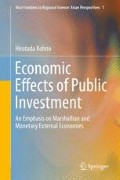Abstract
Generally, the more realistic, complicated policy decision-making problems have, the more objectives. For example, the road construction project has the objective to contribute to the effective development of the national economy/regional economy and at the same time to contribute to the preservation of natural environment/living environment, especially recently (hereinafter, depending on [1], [3]).
Access this chapter
Tax calculation will be finalised at checkout
Purchases are for personal use only
Notes
- 1.
The permissible range of attribute is not necessary to be the inequality indicated the above. It will be \( {x}_i^w\leqq {x}_i\leqq {x}_i^b \), for the usual ordinary goods , and \( {x}_i^b\leqq {x}_i\leqq {x}_i^w \), for the environmental index.
- 2.
Lottery is to be “a lot.”
- 3.
Here, the \( {\overline{x}}_i \) of the conditional utility function \( {U}_i\left({x}_{i,}{\overline{x}}_i\right) \) is to be fixed at a certain value.
- 4.
What is the certainty equivalent? It is the certain value of x i which gives the level of utility equivalent to the expected utility of lottery .
- 5.
\( {k}_iU\left({x}_i^w\right)=0;{k}_jU\left({x_j}^w\right)=0. \)
- 6.
\( E\left[U\left(\tilde{x}\right)\right] \) stands for the expected utility of lottery \( \tilde{x} \).
- 7.
\( {k}_2{U}_2\left({\overline{x}}_i^w\right)=0;{k}_1{U}_1\left({\overline{x}}_i^w\right)=0 \)
- 8.
The following can be said about the general form of U i = U i (x i ). That is, the U i (x i ) according to \( \widehat{x}{}_{<}{}^{\geqq }p_i{x}_i^b+\left(1-{p}_i\right){x}_i^w \) for p i (0 ≦ p i ≦ 1) takes the form of (1) concave function, (2) linear function, and (3) convex function, respectively; they are to be shown in Fig. 7.3.
- 9.
The expected utility of these two lotteries can be obtained by using the additive utility function and the multiplicative utility function as follows:
-
1.
A case of additive utility function
$$ E\left[U\left({\tilde{x}}_{ij},{\overline{x}}_{ij}^{\kern0.5em w}\right)\right]=\frac{1}{2}\left({k}_i+{k}_j\right),\ E\left[U\left({\tilde{\tilde{x}}}_{ij},{\overline{x}}_{ij}^{\kern0.5em w}\right)\right]=\frac{1}{2}\left({k}_i+{k}_j\right) $$ -
2.
A case of multiplicative utility function
$$ E\left[U\left({\tilde{x}}_{ij},{\overline{x}}_{ij}^{\kern0.5em w}\right)\right]=\frac{1}{2}\left({k}_i+{k}_j+k{k}_i{k}_j\right),\ E\left[U\left({\tilde{\tilde{x}}}_{ij},{\overline{x}}_{ij}^{\kern0.5em w}\right)\right]=\frac{1}{2}\left({k}_i+{k}_j\right) $$
Due to k ≠ 0, this identifying method can be understood.
The expanding of equations is as follows:
$$ \begin{array}{c}\frac{1}{2}{\left.\left\{1\right.+kU(x)\right\}}_B+\frac{1}{2}{\left.\left\{1\right.+kU(x)\right\}}_D=\frac{1}{2}\left\{1+k{k}_1{U}_1\left({x}_1^b\right)\right\}\left\{1+k{k}_2{U}_2\left({x}_2^b\right)\right\}\\ {}=\frac{1}{2}\left\{1+k{k}_1\right\}\left\{1+k{k}_2\right\}=\frac{1}{2}\left\{1+k{k}_2+k{k}_1+{k}^2{k}_1{k}_2\right\}\\ {}=\frac{1}{2}\left\{1+k\left({k}_1+{k}_2+k{k}_1{k}_2\right)\right\}\end{array} $$$$ \frac{1}{2}\left\{1+kU(x)\right\}=\frac{1}{2}\left\{1+k\left({k}_1+{k}_2+k{k}_1{k}_2\right)\right\} $$$$ \therefore \kern0.5em \frac{1}{2}U(x)=\frac{1}{2}\left({k}_1+{k}_2+k{k}_1{k}_2\right). $$ -
1.
- 10.
On an earlier occasion, the questionnaire sheets of five attributes , i.e., X 1 = monthly income, X 2 = monthly residential expenditures, X 3 = monthly living expenditures, X 4 = commuting time, and X 5 = noise, have been made, for the pair of which the utility independent is verified, but preferentially independent was not verified.
References
Keeney, Ralf L. 1974. Multiplicative utility functions. Operations Research 22: 22–34.
Yoshida, Masatoshi (Translated). 1977. Tazokusei kōyō kansu (Multiplicative utility functions). Expressways and Automobiles 20(6): 58–66.
Keeney, Ralf L. 1972. Utility functions for multiattributed consequences. Management Sciences 18: 276–287.
Keeney, Ralf L. 1975. Energy policy and value tradeoffs. IIASA research memorandum, RM-75-076, 1–68. Laxenbarg, Austria.
Nair, Keshavan, and Ralf L. Keeney. 1975. Selecting nuclear power plants sites using decision analysis. San Francisco: Woodwarde-Clyde Consultants.
Keeney, Ralf L. 1973. A decision analysis with multiple objectives: The Mexico City Airport. The Bell Journal of Economics and Management Science 4(1): 101–117.
Keeney, R.L., and Eric F. Wood. 1977. An illustrative example of the use of multiattribute utility theory for water resource planning. Water Resources Research 13(4): 705–712.
de Neufville, Richard, and R.L. Keeney. 1972. Chapter 23: Use of decision analysis in airport development for Mexico City. In Analysis of public systems, ed. A.W. Drake, R.L. Keeney, and P.M. Morse, 497–519. Cambridge, MA/London: The MIT Press.
Kohno, Hirotada, Yoshiro Higano, and M. Yoshida. 1977. Measurement of evaluation rate of public pollution using the multi-attributed utility function. In Studies in regional science, The 13th (s.51) annual meeting report, vol. 7, 225–245. Tokyo: Japan Regional Science Association.
Kohno, H., Tetsuo Ogawa, and M. Yoshida. 1979. Social costs and the evaluation rate of public pollution – Based on indirect utility function and expenditure function. In Studies in regional science, The 15th (s.54) annual meeting report, vol. 9, 59–75. Tokyo: Japan Regional Science Association.
Kohno, H., T. Ogawa, M. Kawase, and M. Yoshida. 1978. Theory and measurement of the evaluation rate of public pollution—first last. Expressways and Automobiles 21(8): 22–26 & 21(9): 23–28.
Social costs research committee on metropolitan express highway (ed.). 1977. Measuring research of social costs on metropolitan express highway. Tokyo: Foundation Metropolitan Express Highway Society.
Seo, Fumiko. 1973. Optimization of multi-objective problem and the regional environmental assessment. The Bell Journal of Economics and Management Science 4(1): 95–111.
Author information
Authors and Affiliations
Rights and permissions
Copyright information
© 2016 Springer Japan
About this chapter
Cite this chapter
Kohno, H. (2016). Measurement of Evaluation Rate of Public Pollution (Noise). In: Economic Effects of Public Investment. New Frontiers in Regional Science: Asian Perspectives, vol 1. Springer, Tokyo. https://doi.org/10.1007/978-4-431-55224-6_7
Download citation
DOI: https://doi.org/10.1007/978-4-431-55224-6_7
Published:
Publisher Name: Springer, Tokyo
Print ISBN: 978-4-431-55223-9
Online ISBN: 978-4-431-55224-6
eBook Packages: Economics and FinanceEconomics and Finance (R0)

